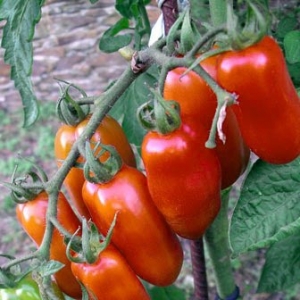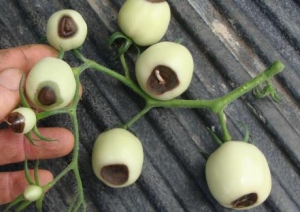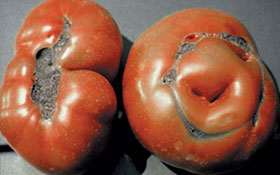Growing Tomatoes 101

Roma tomato ‘San Marzano’
by Pat Dickey, Fairfax Master Gardener
One of the most enjoyable experiences of summer is the mouth-watering taste of a fresh tomato. Without much effort, you can grow tomatoes in your home or community garden. There is still time to plant them in June, since we have a long growing season in our area. Begin by selecting the type of tomato that you most like to eat.
If you want to make fresh tomato sauce, grow paste or Roma tomatoes, such as San Marzano. For snacking and salads, plant cherry tomatoes like Sun Gold or Red Cherry. For sliced tomatoes, try larger varieties like Cherokee Purple or Mortgage Lifter. If you enjoy Mexican cooking, plant tomatillos (husk tomatoes) in green or purple varieties. Be sure to read the tag on the plants when purchasing them.
Determinate tomatoes produce their fruit all at once, while indeterminate ones will give you tomatoes all during the growing season. Hybrids with notations of V, F, N or T are resistant to viruses, fungus, and nematodes, but may not have the taste of heirloom varieties.

Blossom end rot on young tomatoes
Successful tomatoes need full sun six to eight hours per day. Their planting area should be well-drained loam. Begin by breaking up the soil, removing all weeds, digging the plot to a depth of 8 to 10 inches, if possible, and adding organic compost. Choose healthy plants 6 to 10 inches tall. Place them 18 to 24 inches apart, with 30 to 40 inches between rows. Fill each planting hole with a quarter cup of garden lime to help prevent blossom end rot, a calcium deficiency.
Position the plants deeply enough so that the bare stems are covered with soil, and only two or three sets of true leaves are above ground. Provide support for the new plants from the first day to prevent later disturbing of developing roots. Stakes, cages, or trellises will keep them up off the ground for easier harvest and will diminish damage from animals, insects, and rot.
After three or four weeks, when blossoms form, add compost around the plants and reapply every three weeks or so. Avoid the use of high nitrogen fertilizer, which may result in lush foliage but less fruit and can also cause cracking of the fruit and end rot.

Catfacing on tomatoes
Once the soil is consistently warm, mulch with straw, chopped leaves, or grass clippings to keep weeds from growing and to prevent rain and irrigation water from splashing on the bottom leaves and causing disease, such as early blight. Maintain a consistent water supply, especially in times of drought and when blossoms are forming. It is important to position irrigation devices toward the roots and away from the leaves. Fungus diseases can result from too much watering of the foliage. Deep watering is best, rather than light and frequent watering, and water early in the day. Daytime temperatures above 90 degrees and night temperatures above 70 degrees will result in reduced blossoms and fruit. Cool temperatures below 50 degrees can cause catfacing of the fruit.
Insects, such as tomato hornworms and stink bugs, should be handpicked for control. Never use toxic chemicals. Plant basil and flowers nearby to attract bees that will pollinate your tomato plants. Use deer repellants if needed. Pick tomatoes when they are firm but not completely ripe so that insects and birds will not damage them. They will ripen on the kitchen counter without light, but do not refrigerate them. Remember to change the planting location in your garden next year to prevent soil-borne diseases.
References
Tomatoes, Virginia Cooperative Extension
Vegetable Profiles: Tomatoes, University of Maryland Extension